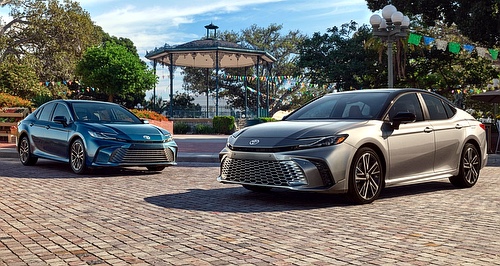Make / Model Search
Future models - Toyota - CamryUS info’ hints at Camry Hybrid spec’ for OzMore powerful and responsive fifth-gen’ hybrid system may yield Camry a 13kW improvement16 Nov 2023 By MATT BROGAN TOYOTA Australia this week announced details of its hybrid-only Camry for the local market, due in the latter part of next year. However, with local spokespersons not yet able to provide key specification and technical information, it is details from the North American market that will fill in some of the detail surrounding the ninth-generation Toyota sedan.
According to the North American press release, the 2025 Toyota Camry Hybrid will utilise the pairing of a 2.5-litre four-cylinder engine with Toyota’s fifth-generation hybrid system with two electric motors to net 225hp (168kW) on front-wheel drive models and 232hp (173kW) on all-wheel drive models, now with an electrically motivated rear axle.
While it is not confirmed whether Australian-delivered Camry variants will offer the same output, the numbers show a promising uptick in performance over the current generation sedan, which delivers 160kW from a familiar 2.5-litre petrol and electric motor combination. Australian models are likely to remain front-wheel drive only.
Toyota has yet to advise fuel economy and emissions data for its latest Camry, though we expect an incremental improvement over the current model’s 4.2-litre per 100km Combined cycle number and 96 grams per kilometre CO2 figure.
Announced in 2018, the fifth generation of Toyota’s petrol-electric hybrid driveline features lighter, more compact, and higher-powered electric motors which are said to increase the electric drive ratio of the hybrid system providing among other benefits longer all-electric range.
As a result, the unit can offer more power and better overall performance when compared with the fourth-generation unit, alongside improved fuel efficiency and lower CO2 emissions.
A redesigned power control unit and transaxle motor, and lighter lithium-ion battery pack further reduce weight, while also delivering important driveability traits – and quieter running under load Toyota says will feel more natural and rewarding to drivers.
Unlike the previous arrangement, which focused primarily on linear acceleration, the fifth-gen system offers throttle response Toyota says more closer mirrors the driver’s intention and use of the throttle pedal, producing an appropriate reaction.
So, does the hybrid have what it takes to make this the most powerful Camry yet?
Looking back across the generations we find the first Aussie-delivered Camry making a maximum of 88kW from its 2.0-litre four-cylinder petrol, though a 118kW iteration was found in the Japanese Domestic Market. Our second-gen Camry – and the first to be built locally – made 116kW when optioned with Toyota’s 2.5-litre V6.
When Toyota shifted to the wide-body Camry locally in 1992, power jumped to as much as 138kW in V6 form, while the 2.2-litre I4 made 97kW. Power stepped up again when the fourth-generation Camry landed in 1997, familiar 2.2-litre ‘four’ and 3.0-litre ‘six’ petrol engines offering 99kW and 143kW respectively (in the US a supercharged variant was offered with 184kW).
A larger displacement 2.4-litre petrol arrived next with 118kW, alongside a very spirited 3.5-litre V6 with 200 killer wasps (and available in the Aussie-badged Aurion). The following generation Camry again offered four- and six-cylinder market, depending on market, making 151kW in petrol form, 155kW in hybrid form, and 224kW with the V6 pairing.
The shorter answer is that, no, the latest Camry is not the most powerful we’ve yet to experience, but it is the most powerful hybrid – and one that is sure to be amongst the most efficient and most driveable we have yet to experience.
Visit GoAuto again soon for more information about the 2024 Toyota Camry Hybrid.  Read more15th of November 2023  Hybrid only for next-gen Toyota CamryToyota will only offer hybridised power in next-generation Camry sedan, due H2 202414th of November 2023  Toyota explains hot hydrogen tech advantagesEngineer outlines hydrogen ICE benefits as Toyota works on upping power, lowering NOx13th of November 2023  Aussie trial central to Toyota H2-ICE programLocal testing, market feedback has ‘critical’ role in Toyota hydrogen ICE validation11th of November 2023  Toyota HiAce H2 a global hydrogen pilotAustralian program to pave the way forward for hydrogen internal combustion technologyAll future modelsCamry pricing
Motor industry news |
Click to shareToyota modelsResearch Toyota All future modelsCamry pricing
Motor industry news |



 Alfa Romeo
Alfa Romeo Abarth
Abarth Audi
Audi Aston Martin
Aston Martin BMW
BMW Bentley
Bentley Ferrari
Ferrari Chevrolet
Chevrolet Ford
Ford Fiat
Fiat GWM
GWM Foton
Foton Hyundai
Hyundai Honda
Honda Jaguar
Jaguar Isuzu
Isuzu Kia
Kia Jeep
Jeep Land Rover
Land Rover Lamborghini
Lamborghini Maserati
Maserati Lexus
Lexus McLaren
McLaren Mazda
Mazda Mercedes-Benz
Mercedes-Benz Mitsubishi
Mitsubishi Mini
Mini Peugeot
Peugeot Nissan
Nissan Ram
Ram Porsche
Porsche Rolls-Royce
Rolls-Royce Smart
Smart Skoda
Skoda Suzuki
Suzuki Subaru
Subaru Toyota
Toyota Tesla
Tesla Volvo
Volvo Zeekr
Zeekr







Facebook Twitter Instagram